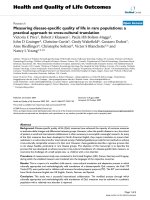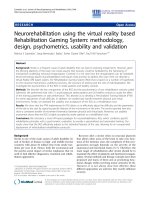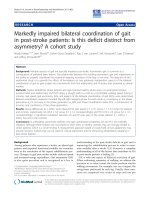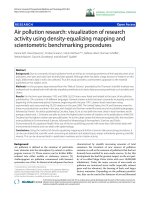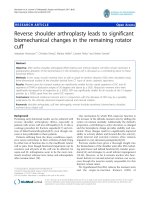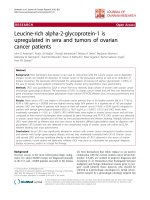báo cáo hóa học: " Effect on Health-related Quality of Life of changes in mental health in children and adolescents" pot
Bạn đang xem bản rút gọn của tài liệu. Xem và tải ngay bản đầy đủ của tài liệu tại đây (208.03 KB, 7 trang )
BioMed Central
Page 1 of 7
(page number not for citation purposes)
Health and Quality of Life Outcomes
Open Access
Research
Effect on Health-related Quality of Life of changes in mental health
in children and adolescents
Luis Rajmil*
1,2,3
, Jorge A Palacio-Vieira
1
, Michael Herdman
2,3
, Sílvia
López-Aguilà
1
, Ester Villalonga-Olives
2,3
, Josep M Valderas
2,3,4
,
Mireia Espallargues
1,3
and Jordi Alonso
2,3
Address:
1
Catalan Agency for Health Technology Assessment and Research (CAHTA), Roc Boronat 81-95 2nd Floor, Barcelona 08005, Spain,
2
Health Services Research Unit, Institut Municipal d'Investigació Mèdica (IMIM-hospital del mar), Dr Aiguader 88, Barcelona 08003, Spain,
3
CIBER en Epidemiología y Salud Pública (CIBERESP), Dr Aiguader 88, Barcelona 08003, Spain and
4
National Primary Care Research and
Development Centre and NIHR School for Primary Care Research, University of Manchester, Williamson Building Oxford Road, Manchester M13
9PL, UK
Email: Luis Rajmil* - ; Jorge A Palacio-Vieira - ;
Michael Herdman - ; Sílvia López-Aguilà - ; Ester Villalonga-Olives - ;
Josep M Valderas - ; Mireia Espallargues - ; Jordi Alonso -
* Corresponding author
Abstract
Background: The objective of the study was to assess the effect of changes in mental health status
on health-related quality of life (HRQOL) in children and adolescents aged 8 - 18 years.
Methods: A representative sample of Spanish children and adolescents aged 8-18 years completed
the self-administered KIDSCREEN-52 questionnaire at baseline and after 3 years. Mental health
status was measured using the Strengths and Difficulties Questionnaire (SDQ). Changes on SDQ
scores over time were used to classify respondents in one of 3 categories (improved, stable,
worsened). Data was also collected on gender, undesirable life events, and family socio-economic
status. Changes in HRQOL were evaluated using effect sizes (ES). A multivariate analysis was
performed to identify predictors of poor HRQOL at follow-up.
Results: Response rate at follow-up was 54% (n = 454). HRQOL deteriorated in all groups on
most KIDSCREEN dimensions. Respondents who worsened on the SDQ showed the greatest
deterioration, particularly on Psychological well-being (ES = -0.81). Factors most strongly
associated with a decrease in HRQOL scores were undesirable life events and worsening SDQ
score.
Conclusions: Changes in mental health status affect children and adolescents' HRQOL.
Improvements in mental health status protect against poorer HRQOL while a worsening in mental
health status is a risk factor for poorer HRQOL.
Background
Mental health status has been shown to be significantly
correlated with health-related quality of life (HRQOL) in
both adult [1] and pediatric [2] populations. In fact, chil-
dren with mental health problems have been reported to
have poorer HRQL than children with physical disorders
Published: 23 December 2009
Health and Quality of Life Outcomes 2009, 7:103 doi:10.1186/1477-7525-7-103
Received: 28 June 2009
Accepted: 23 December 2009
This article is available from: />© 2009 Rajmil et al; licensee BioMed Central Ltd.
This is an Open Access article distributed under the terms of the Creative Commons Attribution License ( />),
which permits unrestricted use, distribution, and reproduction in any medium, provided the original work is properly cited.
Health and Quality of Life Outcomes 2009, 7:103 />Page 2 of 7
(page number not for citation purposes)
[3]. Likewise, children's mental disorders were shown to
interfere significantly not only with their daily lives but
with those of parents and families as well.
Most of the studies performed to date on the association
between HRQOL and mental health in children have been
cross-sectional [2-4]. Few, if any, studies have examined
this association using a longitudinal design. In compari-
son with cross-sectional studies, longitudinal studies help
to provide a clearer picture of the direction and magnitude
of change in HRQOL, to identify factors associated with
change over time, to identify particularly vulnerable pop-
ulations or dimensions in which changes are most
marked, and to confirm the results of cross-sectional stud-
ies. Determining the association between changes in men-
tal health status and changes in HRQOL is important
because it allows us to examine the extent to which
improvements in psychopathology correspond to
improvements in quality of life and, conversely, to inves-
tigate the effect of a deterioration or persistence of mental
problems in terms of their impact on burden of disease.
The European KIDSCREEN study was conducted to
develop a generic HRQOL questionnaire for children and
adolescents 8-18 years old in 13 European countries [5].
In order to study the evolution over time of HRQOL
measured using the KIDSCREEN instrument, a follow-up
study was performed 3 years after the initial KIDSCREEN
administration in the Spanish sample. One of the meas-
ures included at both study contacts was the Strengths and
Difficulties Questionnaire (SDQ) which was designed to
assess mental health status in the pediatric general popu-
lation [6]. The inclusion of this questionnaire in the lon-
gitudinal study alongside the KIDSCREEN-52 instrument
made it possible to study the degree of association
between changes in mental health status and HRQOL.
The primary objective of the study was to assess whether
changes in mental health status were associated with
changes in HRQOL in children and adolescents aged 8 -
18 years. The potential mediating effect of gender and
socio-economic status was also examined.
Methods
Sample and data collection
The Spanish KIDSCREEN baseline sample was recruited
between May and November 2003 as part of the European
KIDSCREEN fieldwork [5]. The target population for the
KIDSCREEN study was children and adolescents aged 8-
18. The aim was to recruit a sample that was representative
by gender and 2 age groups (8-11 and 12-18 years old) in
each participating country according to census data. Tele-
phone sampling was performed centrally from Germany,
and was carried out using a Computer Assisted Telephone
Interview (CATI) with random-digital-dialing (RDD).
Households were contacted by telephone and asked to
participate by interviewers who had received study-spe-
cific training. If the family member contacted agreed to
participate, the questionnaire and other study materials
were mailed to the requisite address together with a
stamped, addressed envelope for return of the completed
questionnaire. A telephone hotline was used to provide
further information about the survey. Two reminders were
sent in cases of non-response (after two and five weeks)
[7].
Between May and November 2006, follow-up question-
naires were posted by mail to all children/adolescents and
their parents who had previously agreed to participate in
the follow-up (n = 840 of 926 participants at baseline).
The fieldwork followed the same methodology as used at
baseline [7]. Postal reminders were sent four and eight
weeks after the first mailing to those who had not
returned their completed questionnaires. A third
reminder was sent after twenty weeks and any remaining
non-respondents were contacted by phone. Additionally,
the proxy respondent who responded to the postal ques-
tionnaire was contacted at a later date by phone and asked
to complete a psychiatric interview.
Measures
HRQOL was measured at baseline and follow-up using
the KIDSCREEN-52 questionnaire, a self-reported, generic
measure of HRQoL for use in children and adolescents
[8]. The KIDSCREEN-52 measures HRQOL in 10 dimen-
sions: Physical Well-being (PH, 5 items); Psychological
Well-being (PW, 6 items); Moods & Emotions (ME, 7
items); Self-Perception (SP, 5 items); Autonomy (AU, 5
items); Parent Relation & Home Life (PA, 6 items); Social
Support & Peers (PE, 6 items); School Environment (SC,
6 items); Social Acceptance (bullying) (BU, 3 items), and;
Financial Resources (FI, 3 items). The KIDSCREEN items
use 5-point Likert-type scales to assess either the frequency
(never-seldom-sometimes-often-always) or intensity (not
at all-slightly-moderately-very-extremely). The recall
period is 1 week.
Scores for each dimension are calculated using Rasch
analysis [5] and then transformed into T-values with a
mean of 50 and a standard deviation (SD) of 10. Higher
scores indicate better HRQoL. KIDSCREEN-52 T scores
refer to the mean values and SD from a representative
sample of the European general population. In addition
to the dimension scores, the KIDSCREEN-10 index was
calculated as a global score for the longer version of the
instrument [5]. The Spanish version of the KIDSCREEN-
52 has been shown to have acceptable levels of reliability
and validity [9].
As the KIDSCREEN was developed for use in population
aged 8 - 18, both adolescent and parent versions of the
scale were assessed for feasibility and relevance in popula-
Health and Quality of Life Outcomes 2009, 7:103 />Page 3 of 7
(page number not for citation purposes)
tion aged 19 - 21 years old in a pilot test (age range at fol-
low-up of patients aged 16-18 at baseline, unpublished
data). This confirmed that the instrument was applicable
in this population.
Other variables collected in the present study were age,
sex, family socio-economic status, and parental level of
education. Socio-economic status was measured using the
Family Affluence Scale (FAS) [10], which includes family
car ownership, having their own unshared room, the
number of computers at home, and how many times they
spent on holidays in the past 12 months. FAS scores were
categorized as low (0-3), intermediate (4-5), and high (6-
7) affluence level. Socio-demographic information col-
lected from parents included the highest family level of
education according to the International Standard Classi-
fication of Education (ISCED) categorized as low (at most
lower secondary level, ISCED 0-2); medium (upper sec-
ondary level, ISCED 3-4), and; high (university degree,
ISCED 5-6) [11]. Baseline values for the FAS and Family
level of education were used in the present analysis.
Children's mental health status was assessed using the
Strengths and Difficulties Questionnaire (SDQ) collected
from parents. The SDQ is a brief behavioural screening
questionnaire for children and adolescents aged 4 - 16
that asks about their mental health symptoms and posi-
tive attitudes6. The instrument consists of 25 items meas-
uring 5 dimensions of emotional symptoms, conduct
problems, hyperactivity/inattention, peer relationship
problems, and pro-social behaviour. All items are scored
on a three point scale with 0 = not true, 1 = somewhat
true, and 2 = certainly true. Higher scores indicate more
problems except on the pro-social behaviour dimension.
Items in the 4 problem dimensions are summed to give a
total difficulties score ranging from 0 (no problems) - 40
(maximum problems). The SDQ has shown acceptable
levels of validity in several studies [12-16]. The Spanish
version has been shown to be reliable and valid [17]. Life
events were assessed using the Coddington Life Events
Scale (CLES) [18].
The instrument measures the occurrence during the previ-
ous year of 53 stressful life events. The impact of those
events is measured in terms of Life Change Units (LCU)
based on how recently and how frequently a particular life
event occurred (more recent and repeated events are asso-
ciated with higher scores). The Spanish version was
recently adapted and shown to be reliable and valid [19].
Statistical analysis
Sample characteristics at baseline and follow-up were cal-
culated and compared using independent t tests or chi
squared tests as appropriate. Respondents were classified
into 3 categories according to differences between 2003
and 2006 on the SDQ total difficulties score. The 3 cate-
gories were those who scored below -1 Standard Devia-
tion (SD) from the mean (improved), those who scored
above +1 SD (worsened), and the remainder of the
respondents (stable). Effect sizes (ES) between adminis-
trations for the 3 groups were calculated for KIDSCREEN-
52 dimensions and the index, and ES of (0.2-0.5), (0.51-
0.8) and (> 0.8) were considered small, medium, and
large, respectively [20].
Ordinary least square regression models were used to esti-
mate the effect of independent variables of interest (SDQ
scores; life events) on KIDSCREEN-52 dimension scores
and the index at follow-up. Only undesirable life events
were included in the model as previous research had
shown that these had a much stronger effect on HRQOL
than other types of event [21]. We tested and discarded for
co-linearity between independent variables before carry-
ing out the multiple regression analysis. All models were
adjusted by age, gender, socio-economic status, and KID-
SCREEN score at baseline. Dependent variables were
tested for normality before carrying out multivariate anal-
ysis. The level of statistical significance was set at 0.05 and
analysis was adjusted for multiple comparisons using the
Bonferroni method.
Results
A total of 840 children and their parents participated at
baseline and 454 at follow-up (response rate = 54%).
Table 1 shows the sample characteristics at baseline and
follow-up. When compared with non-respondents at fol-
low-up, respondents were younger with a slightly higher
parental level of education.
Table 2 shows KIDSCREEN scores at baseline and follow-
up and effect sizes between administrations for each of
the 3 change categories studied (improved, stable, and
worsened). In general, HRQOL deteriorated over time in
all 3 categories and on almost all of the KIDSCREEN-52
dimensions and the index. Deterioration was much more
marked in the groups classified as 'worsened' in almost all
KIDSCREEN dimensions and index, ranging from an ES =
-0.81 (PW) to 0.18 (BU). The group classified as
'improved' showed the smallest overall reduction in
HRQOL, ranging from an ES = -0.26 (AU) to 0.51 (BU).
The 'stable' group started above the 50 score which reflects
the European average, and showed minimal to moderate
deterioration at the end, ranging from ES = -0.35 on Self-
perception to 0.35 in Bullying. The "improved' group
started below 50 mainly in physical and psychological
dimensions and showed even slightly higher scores than
the 'stable' group at follow-up. The only KIDSCREEN-52
dimension to show improvement was the bullying
dimension, with improvement being observed in all three
groups.
Health and Quality of Life Outcomes 2009, 7:103 />Page 4 of 7
(page number not for citation purposes)
Table 3 shows the results of the linear regression model
used to analyze the association between mental health
variables and HRQOL scores in 2006 after adjusting by
socio-demographic variables and baseline HRQOL. The
two factors with the strongest influence on HRQOL scores
in 2006 were the SDQ 'worsened' category and undesira-
ble life events in the past 3 years. For example, an undesir-
able life event such as breaking up with a boyfriend/
girlfriend would be associated with a decrease of
(weighted life event units = 39* [-1.7]/10) 6.6 points on
the KIDSCREEN School Environment dimension
(between 0.5 and 1 standard deviation). SDQ category of
'worsened' most strongly influenced the dimensions of
psychological well-being, moods and emotions, auton-
omy and parents. Notably, undesirable life events were
associated with deterioration on all HRQOL dimensions
except that of Peers, which showed a statistically signifi-
cant improvement. R
2
ranged from 0.16 to 0.33. No sig-
nificant differences were found after stratifying the sample
by age and gender.
Discussion
We found that HRQOL worsened as a whole in this sam-
ple of children and adolescents followed over 3 years, but
that the decline was much more marked in those whose
mental health deteriorated. In those whose mental health
remained stable or improved over the study period, the
decline in HRQOL was relatively slight. Regression mod-
elling showed that current HRQOL was more influenced
by worsening mental health and undesirable life events in
the past 3 years than by the other factors included.
The study had some limitations. Firstly, the response rate
at follow-up was only 54% and there were some differ-
ences between participants and non-participants. As a
consequence, a selective follow-up could have biased our
Table 1: Sample characteristics at baseline and participants at the Spanish KIDSCREEN follow-up study
N (%) Participants
N (%)
Non-participants
N (%)
p-value Degree of freedom
Gender
Boys 420 50 218 (48%) 202 (52.5%) 0.213 1
Family Affluence Scale
Low 167 20.2 83 (18.7%) 84 (22.1%)
Middle 411 49.9 224 (50.5%) 187 (49.2%) 0.458 2
High 246 29.9 137 (30.9%) 109 (28.7%)
Parental level of education
Primary 356 43.2 177 (39.4%) 179 (47.7%)
Secondary 195 23.7 119 (26.5%) 76 (20.3%) 0.032 2
University 273 33.1 153 (34.1%) 120 (32.0%)
Age (mean, SD) 12.91 (2.91) 12.71 (2.88) 13.14 (2.92) 0.031 838
SDQ total difficulties (mean, SD) 8.14 (5.04) 7.89 (4.84) 8.43 (5.24) 0.130 809
SDQ: Strengths and Difficulties Questionnaire SD: Standard deviation
Missing values: FAS: 16; Parental level of education: 16; SDQ:16
Table 2: Mean Scores on the KIDSCREEN-52 dimensions and Index according to the 3 analyzed categories in the Strengths and
Difficulties Questionnaire (SDQ) at baseline and in the follow-up, and effect size (ES)
PH PW ME SP AU PA PE SC BU FI INDEX
Improvement (n = 43)
Follow-up 48.9 50.7 52.2 46.8 51.3 51.8 51.8 52.6 53.7 52.5 52.6
Baseline 49.2 49.3 49.7 48.6 54.2 52.3 53.6 51.5 48.3 50.9 52.4
Effect size -0.02* 0.14* 0.21* -0.15 -0.26* -0.04 -0.17 0.09 0.51* 0.16 0.01
Stable (n = 339)
Follow-up 48.9 50.0 50.8 47.0 50.3 50.1 51.7 50.8 52.5 52.4 50.3
Baseline 52.4 53.0 51.9 50.0 52.0 52.2 54.6 52.7 49.1 51.3 53.7
Effect size -0.33* -0.32* -0.10 -0.35* -0.19 -0.23* -0.32* -0.18 0.35* 0.13 -0.34*
Worsened (n = 48)
Follow-up 44.9 45.2 44.4 46.0 46.4 46.6 48.5 47.0 51.7 48.8 45.3
Baseline 50.6 53.1 48.9 50.4 52.2 48.8 53.8 52.5 49.9 50.6 51.0
Effect size -0.50* -0.81* -0.44* -0.46* -0.53* -0.19 -0.52* -0.58* 0.18 -0.17 -0.56*
PH: Physical Well-being, PW: Psychological Well-being, ME: Moods & Emotions, SP: Self-Perception, AU: Autonomy, PA: Parent Relation &
Home Life, PE: Social Support &Peers, SC: School Environment, BU: Social Acceptance FI: Financial resources
SDQ was categorized according to differences in the total difficulties scores from parents 2006 2003: improvement (below -1 Standard
Deviation, SD; stable (-1 to +1 SD); or worsened (above +1 SD).
*ES statistically significant at p < 0.05.
Health and Quality of Life Outcomes 2009, 7:103 />Page 5 of 7
(page number not for citation purposes)
assessment of the evolution of HRQOL. Nevertheless, the
response rate was similar to that in other longitudinal
population-based studies [22]. Moreover, although those
followed up were slightly younger and from more edu-
cated families than non-participants, there were no differ-
ences in their baseline KIDSCREEN-52 scores. Secondly,
the 3 year interval between baseline and follow-up and
the fact that there was only one follow-up administration
makes it difficult to establish trends, as many intervening
events may not be captured. Nevertheless, this is one of
few studies to attempt to determine the impact of changes
in mental health on HRQOL in a longitudinal design and
it provides some indication of directionality. Future stud-
ies should consider more, and more frequent study con-
tacts. One further major limitation of this study is that it
was not possible to perform structured clinical interviews,
and results and conclusion were based on self and parents'
reports data by mails. Probably this will significantly
decrease the validity of the data given the absence of psy-
chiatric diagnosis. Nevertheless, the SDQ has been widely
used as a screening tool and has been shown to be reliable
and valid in detecting possible cases of psychopathology
[6,16]. It has also been proposed as one of the principal
tools to be used worldwide for screening purposes as well
as in clinical assessment and cross-cultural comparisons
[23]. Finally, the SDQ and the KIDSCREEN-52 were orig-
inally intended for use in age groups 4 - 16 and 8 - 18,
respectively, and here they were used in subjects who were
above the upper age limit at follow-up. This may have
affected results, though cognitive debriefing in older
respondents suggested that the instruments were accepta-
ble and relevant in participants aged 16 - 21 (unpublished
data).
Strengths of the present study include the fact that it is one
of the first to examine correlations between mental health
and HRQOL in a longitudinal design, thus adding to
knowledge contributed by earlier cross-sectional studies.
For example, we have shown that HRQOL in this age
group declines in general, but that the decline is exacer-
bated in those whose mental health also worsened.
Improvements in mental health appear to act as a protec-
tive factor against this overall decline. The overall deterio-
ration observed is likely due to pubertal changes which
were shown to lead to deterioration in HRQOL in a previ-
ous study [24]. A further strength of the study was the use
of well-validated instruments to measure HRQOL and
mental health. The Spanish versions of the KIDSCREEN-
52 [9] and the SDQ [18] showed good reliability and
validity. For HRQOL measures, it is considered preferable
to use self-report whenever feasible [25]. Likewise, we
obtained ratings of mental health from parents and used
a 1-SD cut point on the measure, thereby applying quite a
strict definition of change on mental health, but one
which ensures a high level of sensitivity. It is, for example,
higher than the 0.8 SD from the mean, which is generally
accepted as representing a large change in patient-
reported outcome measures [26,27]. Moreover, it likely
represents an improvement over previous strategies used
to classify children as cases or non-cases and which
showed relatively low ability to detect cases [16].
The findings are in line with those of other studies which
have shown that children with mental disorders have sig-
nificantly worse HRQOL than children with no such dis-
orders and that they often have worse HRQOL than
children with physical disorders [3]. Other studies in this
Table 3: Multiple regression analysis of KIDSCREEN-52 dimensions and the KIDSCREEN-10 Index at follow-up
PH PW ME SP AU PA PE SC BU FI Index
(Constant) 30.2* 31.3* 29.5* 32.5* 39.9* 30.7* 39.0* 33.6* 38.0* 40.1* 36.2*
Age -0.4 -0.1 0.1 -0.2 -0.5* 0.2 -0.2 0.0 -0.1 -0.4 -0.2
Gender 2.4-0.10.93.0* 0.5 -0.5 -3.1* -1.1 -0.8 -0.9 0.3
FAS
Low 0.3 0.0 1.0 1.6 2.0 -1.0 1.7 -0.9 -0.5 -3.0 0.8
Medium 0.4 -0.2 0.3 0.8 0.0 -1.0 1.0 0.0 -0.1 -1.8 0.6
Parental education
Primary school -0.6 1.0 1.0 0.7 0.4 1.0 -2.1 0.2 0.2 -0.7 -0.6
Secondary school -1.0 0.9 0.8 0.3 -0.1 0.1 -2.6 -0.8 0.3 -0.8 -0.3
Kidscreen Baseline score 0.4* 0.4* 0.4* 0.2* 0.3* 0.4* 0.4* 0.4* 0.3* 0.4* 0.3*
SDQ
Improvement 1.4 1.9 2.2 -0.5 0.0 1.5 0.6 2.3 1.3 0.3 3.0
Worsened -3.2 -4.6* -5.2* -1.1 -3.9* -1.9 -3.0 -2.9 -0.6 -2.4 -4.0*
Undesirable life events -1.2* -1.2* -1.0* -0.3 -0.1 -1.4* 0.9* -1.7* -0.7 -0.6 -1.3*
R
2
0.31 0.25 0.21 0.20 0.14 0.19 0.20 0.26 0.15 0.25 0.31
PH: Physical Well-being, PW: Psychological Well-being, ME: Moods & Emotions, SP: Self-Perception, AU: Autonomy, PA: Parent Relation &
Home Life, PE: Social Support &Peers, SC: School Environment, BU: Social Acceptance FI: Financial resources.
FAS: Family Affluence Scale
SDQ: Strengths and Difficulties Questionnaire;
Reference category: Gender: female; FAS: low family affluence; Parental level of education: university degree; SDQ: stable.
*Statistically significant beta coefficients after correction for multiple comparisons (p < 0.005).
Health and Quality of Life Outcomes 2009, 7:103 />Page 6 of 7
(page number not for citation purposes)
area have also shown that specific HRQOL sub-domains
are associated with distinct diagnostic categories such as
attention-deficit and disruptive disorders, anxiety disor-
ders, pervasive developmental disorder and others [4].
Longitudinally designed studies to assess the impact of
mental health problems on HRQOL have primarily
focused on analyzing changes in specific symptoms or
clinical outcomes in diseases such as attention deficit
hyperactivity disorder in samples of children attending
health services [28,29]. A cross-sectional study of the rela-
tionship between mental health and HRQOL in repre-
sentative samples of children and adolescents from 12
European countries found a moderate effect size (range
0.21 in Switzerland to 0.44 in the Czech Republic) on the
KIDSCREEN-10 index when children categorized as with-
out mental health problems were compared with proba-
ble cases [30]. These results are similar to those from the
BELLA study, a longitudinal study to collect information
on mental health and HRQOL in a representative sample
of German children and adolescents and their parents
[31]. Although only cross-sectional baseline data are cur-
rently available, the authors also found lower HRQOL in
children classified as a probable or possible case of mental
health problems on the SDQ compared with healthy chil-
dren. Again, the HRQOL of these children was found to be
poorer than that of children with special health care
needs, or who reported pain or asthma [32]. In the present
study we did not collect data on other specific physical
symptoms or diagnoses. Nevertheless, our study confirms
that persistence of poor mental health or worsening in
mental health status may have a multidimensional effect
on HRQOL 3 years later.
The results of the present study also adds to earlier find-
ings that one of the better predictors of current psychopa-
thology was previous psychopathology [33,34] in the
sense that those who had psychopathology at any point in
the study had poorer HRQOL than those without psycho-
pathology at any point in the study. This indicates the
considerable importance of mental health on HRQOL
even when mental health improved over the study period.
The apparently paradoxical association between the
occurrence of undesirable life events and an improvement
in HRQOL in the Peers and Social Support dimension
could be explained by the type of life event. For example,
the break-up of a romantic relationship could have a pos-
itive impact on other peer relationships.
Future research should address specific mental health
problems such as attention deficit and hyperactivity and
emotional problems to determine the extent to which
changes in symptoms over time have a corresponding
effect on HRQOL and whether HRQOL after treatment
interventions recovers to the level of the general popula-
tion. Future studies of specific, medium or long-term
interventions (behavioural or other types of therapy)
should also take into account that the natural course of
HRQOL in this population is to decline so benefits from
any interventions in terms of HRQOL might not be as
large as initially expected.
Conclusions
Changes in mental health status can affect HRQOL over
time in children and adolescents. An improvement in
mental health status appears to protect against the general
deterioration seen in this group as a whole, whilst worsen-
ing mental health is a risk factor for more severe deterio-
ration in HRQOL.
Competing interests
The authors declare that they have no competing interests.
Authors' contributions
LR, JMV, ME and JA participated in the conception and
design of the study. LR, JAPV, and EVO analyzed the data.
MH and LR participated in the drafting of the article. All
authors contributed to a critical revision of the manuscript
and made a substantial contribution to its content, and
read and approved the final manuscript.
Acknowledgements
This research was funded by the Instituto de Salud Carlos III grants:
PI042504, PI042315, and CIBER in Epidemiology and Public Health (Insti-
tuto de Salud Carlos III expediente CB 06/02/0046)
References
1. Alonso J, Angermeyer MC, Bernert S, Bruffaerts R, Brugha TS, Bryson
H, de Girolamo G, Graaf R, Demyttenaere K, Gasquet I, Haro JM,
Katz SJ, Kessler RC, Kovess V, Lépine JP, Ormel J, Polidori G, Russo
LJ, Vilagut G, Almansa J, Arbabzadeh-Bouchez S, Autonell J, Bernal M,
Buist-Bouwman MA, Codony M, Domingo-Salvany A, Ferrer M, Joo
SS, Martínez-Alonso M, Matschinger H: Disability and quality of
life impact of mental disorders in Europe: results from the
European Study of the Epidemiology of Mental Disorders
(ESEMeD) project. Acta Psychiatr Scand 2004, 420(Suppl):38-46.
2. Bastiaansen D, Koot HM, Ferdinand RF, Verhulst FC: Quality of life
in children with psychiatric disorders: Self-parent, and clini-
cian report. J Am Acad Child Adoles Psychiatry 2004, 43:221-230.
3. Sawyer MG, Whaites L, Rey JM, Hazell PL, Graetz BW, Baghurst P:
Health-related quality of life of children and adolescents with
mental disorders. J Am Acad Child Adoles Psychiatry 2002,
41:530-537.
4. Bastiaansen D, Koot HM, Ferdinand RF: Determinants of quality
of life in children with psychiatric disorders. Qual Life Res 2005,
14:1599-1612.
5. The KIDSCREEN Group Europe: The KIDSCREEN Questionnaires.
Handbook Lengerich, Germany: Pabst Science Publishers; 2006.
6. Goodman R: Psychometric Properties of the Strengths and-
Difficulties. J Am Acad Child Adoles Psychiatry 2001, 40:1337-1345.
7. Berra S, Ravens-Sieberer U, Erhart M, Tebe C, Bisegger C, Duer W,
von Rueden U, Herdman M, Alonso J, Rajmil L, European KID-
SCREEN group [kidscreen]: Methods and representativeness of
European surveys in children and adolescents: the KID-
SCREEN study. BMC Public Health 2007, 7(1):182.
8. Ravens-Sieberer U, Gosch A, Rajmil L, Erhart M, Bruil J, Power M,
Duer W, Auquier P, Cloetta B, Czemy L, Mazur J, Czimbalmos A,
Tountas Y, Hagquist C, Kilroe J, KIDSCREEN Group: The KID-
SCREEN-52 Quality of Life Measure for Children and Ado-
lescents: Psychometric Results from a Cross-Cultural
Publish with BioMed Central and every
scientist can read your work free of charge
"BioMed Central will be the most significant development for
disseminating the results of biomedical research in our lifetime."
Sir Paul Nurse, Cancer Research UK
Your research papers will be:
available free of charge to the entire biomedical community
peer reviewed and published immediately upon acceptance
cited in PubMed and archived on PubMed Central
yours — you keep the copyright
Submit your manuscript here:
/>BioMedcentral
Health and Quality of Life Outcomes 2009, 7:103 />Page 7 of 7
(page number not for citation purposes)
Survey in 13 European Countries. Value Health 2008,
11:645-658.
9. Tebe C, Berra S, Herdman M, Aymerich M, Alonso J, Rajmil L: Fiabi-
lidad y validez de la versión española del KIDSCREEN-52
para población infantil y adolescente. Med Clín (Barc) 2008,
130:650-654.
10. Boyce W, Torsheim T, Currie C, Zambon A: The Family Affluence
Scale as a Measure of National Wealth: Validation of an Ado-
lescent Self-Report Measure. Soc Indicators Res 2006,
78:473-487.
11. Eurostat: Eurostat yearbook '96 1996. In A statistical view on
Europe 1985-1996 Luxembourg: Eurostat; 1996.
12. Goodman R, Ford T, Corbin T, Meltzer H: Using the Strengths
and Difficulties Questionnaire (SDQ) multi-informant algo-
rithm to screen looked-after children for psychiatric disor-
ders. Eur Child Adolesc Psychiatry 2004, 13(Suppl 2):25-31.
13. Hawes DJ, Dadds MR: Australian data and psychometric prop-
erties of the Strengths and Difficulties Questionnaire. Austr
New Zealand J Psychiatry 2004, 38:644-651.
14. Muris P, Meesters C, Berg F van den: The Strengths and Difficul-
ties Questionnaire (SDQ): further evidence for its reliability
and validity in a community sample of Dutch children and
adolescents. Eur Child Adolesc Psychiatry 2003, 12:1-8.
15. Mathai J, Anderson P, Bourne A: Use of the Strengths and Diffi-
culties Questionnaire as an outcome measure in a child and
adolescent mental health service. Austral Psychiatry 2003,
11:334-337.
16. Goodman R, Ford T, Simmons T, Gatward RA, Meltzer H: Using the
Strengths and Difficulties Questionnaire (SDQ) to screen for
psychiatric disorders in a community sample. Br J Psychiatry
2000, 177:534-539.
17. Cladellas Pardo: Y.El desenvolupament de la personalitat psicopàtica:
pràctiques educatives parentals i altres variables familiars Barcelona: Uni-
versitat Autònoma de Barcelona; 2007.
18. Coddington RD: Coddington Life Events Scales (CLES): Technical Manual
Toronto: Multi Health Systems; 1999.
19. Villalonga-Olives E, Valderas JM, Palacio-Vieira J, Herdman M, Rajmil
L, Alonso J: The adaptation into Spanish of the Coddington
Life Events Scale (CLES).
Qual Life Res 2008, 17:447-452.
20. Cohen J: Statistical power analysis for behavioral sciences Hillsdale, NJ
(US): Lawrence Erlbaum Associates; 1988.
21. Villalonga-Olives E, Palacio-Vieira J, Rojas-Farreras S, Rajmil L, Alonso
J: The association of life events with health-related quality of
life in children and adolescents in the Spanish KIDSCREEN
follow-up study. XIV Anual Scientific Meeting of the International Soci-
ety for Quality of Life Research. Toronto, Qual Life Res :A-26 [http://
www.isoqol.org/2007mtgabstracts.pdf].
22. Hille ET, Elbertse L, Gravenhorst JB, Brand R, Verloove-Vanhorick SP:
Nonresponse bias in a follow-up study of 19-year-old adoles-
cents born as preterm infants. Pediatrics 2005, 116:662-666.
23. Rothenberger A, Woerner W: Strengths and Difficulties Ques-
tionnaire (SDQ)- Evaluations and applications. Eur Child Ado-
lesc Psychiatry 2004.
24. Palacio-Vieira JA, Villalonga-Olives E, Valderas JM, Espallargues M,
Herdman M, Berra S, Alonso J, Rajmil L: Changes in health-related
quality of life (HRQoL) in a population-based sample of chil-
dren and adolescents after 3-years of follow-up. Qual Life Res
2008, 17:1207-1215.
25. Matza L, Swensen AR, Flood EM, Secnik K: Assessment of health-
related quality of life in children: a review of conceptual,
methodological and regulatory issues. Value Health 2004,
7:79-92.
26. Revicki DA, Cella D, Hays RD, Sloan JA, Lenderking WR, Aaronson
NK: Responsiveness and minimal important differences for
patient reported outcomes. Health Qual Life Outcomes 2006,
4:70-74.
27. Guyatt G, Schunemann H: How can quality of life researchers
make their work more useful to health workers and their
patients? Qual Life Res 2007, 16:1097-1105.
28. Matza LS, Rentz AM, Secnik K, Swensen AR, Revicki DA, Michelson
D, Spencer T, Newcorn JH, Kratochvil CJ: The link between
health-related quality of life and clinical symptoms among
children with attention-deficit hyperactivity disorder. J Dev
Behav Pediatr 2004, 25:166-74.
29. Perwien AR, Kratochvil CJ, Faries DE, Vaughan BS, Spencer T, Brown
RT: Atomoxetine treatment in children and adolescents with
attention-deficit hyperactivity disorder: what are the long-
term health-related quality-of-life outcomes? J Chil Adolesc Psy-
chopharmacol 2006, 6:713-24.
30. Ravens-Sieberer U, Erhart M, Gosch A, Wille N, the European KID-
SCREEN group: Mental health of children and adolescents in
12 European countries - Results from the European KID-
SCREEN study. Clin Psychol and Psychotherapy 2008, 15:154-63.
31. Ravens-SIeberer U, Kurth BM, the KIGGS study group and the BELLA
study group: The mental health module (BELLA study) within
the German Health interview and examination survey of
children and adolescents (KIGGS): study design and meth-
ods. Eur Child Adolesc Psychiatry 2008, 17(Suppl 1):10-21.
32. Ravens-Sieberer U, Erhart M, Wille N, Bullinger M, the BELLA study
group: Health-related quality of life in children and adoles-
cents in Germany: results of the BELLA study. Eur Child Aolesc
Psychiatry 2008, 17(Suppl 1):148-56.
33. Ford T, Collishaw S, Meltzer H, Goodman R: A prospective study
of childhood psychopathology: independent predictors of
change over three years. Soc Psychiatry Psychiatr Epidemiol 2007,
42:953-961.
34. Maughan B, Collishaw S, Meltzer H, Goodman R: Recent trends in
UK child and adolescent mental health. Soc Psychiatry Psychiatr
Epidemiol 2008, 43:305-310.

